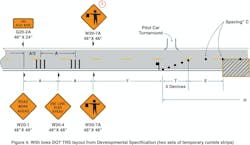Report indicates temporary portable rumble strips are effective in work zones
The Center for Transportation Research and Education (CTRE) at Iowa State University develops methods and technologies to improve transportation safety and reliability.
Last month, CTRE issued a Final Report titled “Field Measurements on the Effect of Temporary Rumble Strips in Work Zone Flagging Operations”. Neal Hawkins, associate director of the Institute for Transportation at Iowa State, and Skylar Knickerbocker, engineer, CTRE, served as authors and investigators.
The Iowa Department of Transportation (IDOT), a co-sponsor of the report, launched a project in 2013 to determine if temporary rumble strips (TRS) would alert drivers to changes in road conditions, such as an upcoming work zone. Specifically, would TRS prove effective as part of flagging operations on two-lane roads, where one lane is closed? Also, would drivers reduce their speed with TRS arrays on the road?
The authors conducted tests to “quantify the impact of TRS” at two locations. In June and July 2015, tests were run in IDOT District 2, on U.S. 52, near Calmar, in northeastern Iowa. The August 2016 tests were run in District 5, on S.R. 92, near Oskaloosa, in southeastern Iowa.
The authors tested the effectiveness of TRS under three different traffic plans:
- IDOT Developmental Specification: (See Report Figure 4, included in this case study). IDOT specified the deployment of two sets of three TRS arrays for each approach direction. Distance between sets were determined by posted speed limits and average daily traffic;
- No TRS Setup: Same plan as above, but without TRS arrays; and
- Modified Specification: Same as the IDot specification, but with one TRS array, and a “Rumble Strips Ahead” sign. The single array was deployed at the location of the upstream array of the IDOT specification.
PSS RoadQuake 2F Temporary Portable Rumble Strips were deployed at both locations for the tests. The authors tested three different factors at both locations:
- Driver avoidance: Did drivers avoid the TRS arrays by driving around them?
- Driver braking behavior: Did drivers apply their brakes when approaching the flagging operation and work zone?
- Changes in speed: Did drivers increase or decrease their vehicle speed during their approach?
The tests were conducted in one approach direction in both work zones; the data collection trailer, which contained speed data and video-analysis equipment, moved with the work zone.
Driver braking data was collected at four locations upstream of the flagging operation and work area, as shown in Report Figure 9, included in this case study. (Please see the previously linked Report for Figure 10, which shows the two locations where speed data was collected.) Though the authors stated they collected field measurements on a “limited-scale”, quantitative results are nevertheless impressive.
Results, Driver Avoidance:
In both upstream and downstream TRS arrays, driver avoidance was minimal, at 1% and 3% respectively.
Results, Driver Braking:
In measurements before and after the upstream and downstream TRS arrays:
- “The overall percentage of drivers braking increased roughly a factor of three when rumble strips were present”; and
- “The overall percentage of drivers braking was 25% when rumble strips were present (standard layout).”
Results, Changes in Speed:
The authors reported the impact on mean speeds:
- No TRS Arrays: 0.1 MPH increase in speed
- IDOT Standard: 5.5 MPH reduction in speed
- Modified Layout: 3.7 MPH reduction in speed
In their summary, the authors began with a caveat: The findings are not comprehensive or consistent with other test methodology. That said, the authors concluded that the effects of TRS arrays in work zones are positive, noting “increased driver braking, minimal driver avoidance and reduced vehicle speeds.”
Last, the authors stated that their report “should serve future study efforts in terms of hypothesis development and testing as part of a controlled evaluation.”
Drivers who encounter TRS arrays in work zones, and as a result apply their brakes or otherwise reduce their speed, are alert, safer drivers. They are not distracted drivers. TRS arrays reduce crashes, save lives, and are effective in work zones.
